Marlin Benedict’s skiff looked pretty tiny compared to the massive Maltese yacht that occupied the same slip the day before.
The big craft cruising the Inside Passage had followed us around Southeast Alaska, visiting Ketchikan and Petersburg before tying up in Wrangell, just outside out the window of our Stikine Inn hotel room. It even managed to follow us to the Anan Creek Bear Observatory—as we wandered down the creek, wary eyes on the lookout for one of the 3-year-old brown bears that we’d seen fishing most of the morning, we could see the massive, pearly yacht anchored offshore and catching a sheen from a rare patch of rainforest sunshine. A small Zodiac rested on the rocky beach at the mouth of the creek.
We wondered, of the dozen or so folks we passed on the trail on the way back to the boat, who belonged to the gaudy craft, floating serenely in the small, sheltered bay over deep, green water. Was it the crew with the polo shirts and the Ivy League sweaters slung over their shoulders? Or the guy outfitted in his best safari attire, wide-brimmed, waxed-canvas hat included? Or all of the above?
“I think it was the guy with the walking stick,” Delaney said to me as we got back to the mouth of the salmon-choked stream. “Did you see that he was wearing loafers?”
Loafers? In Southeast Alaska? Home of the Xtra Tuff?
More Like This
The next day, after we’d climbed into Benedict’s small-but-sturdy skiff and were heading out across the Stikine Delta at the peak of high tide for a day of fishing, Delaney looked at me and said, “I don’t think Marlin would be caught dead in loafers.”
No, indeed.
As Benedict guided the craft out of the no-wake zone, he was in full fishing mode. All wadered up and sitting behind the small wind-shield in the captain’s chair, our guide for the day was busy explaining where the float-coats were stowed and prepping us for what was to come.
“It’ll be cold on the ride over,” he said, looking mainly at my daughter who had, after the better part of a week in Southeast, layered her fishing attire quite nicely. “The float-coat will help keep you warm if you need it.”
Delaney nodded and hunkered down in her chair as Marlin gave his little jet outboard the gas and we started across the strait between Wrangell Island and the mouth of the storied Stikine. The tide had just passed slack and was on the way out, so going was slow, and Benedict was careful to watch for all the random flotsam the glacial-tinged river carried out to sea from its headwaters in British Columbia. Now and then, the intake would pick up a stick or a mass of grass and peat that floated invisibly just beneath the surface of the gray water, and he’d slow us to a crawl and work his magic with the throttle to dislodge whatever it was that had momentarily stalled us.
“Are we going to fish in this?” my 16-year-old daughter asked, gazing out over the flat, muddy expanse of the delta. “How will fish see our flies?”
Marlin shook his head.
“No way,” he said. “This is all from glaciers. All this sediment is what makes the flats on the delta. We’re not going to fish here, but we will fish in a smaller river that flows into it. And that river is clear.”

Sure enough, about a half-hour later, Benedict steered the aluminum skiff into what looked like a side channel of the Stikine. As we pushed through the current, though, the water started to take on a greener tint, and then, almost instantly, it was crystal-clear. The cloudy water of the Stikine simply stopped, and was shoved aside by the transparent waters of a non-glacial tributary to the mighty river.
Benedict kept motoring upstream, slicing the skiff through the deep channel of the river, momentarily splitting massive schools of migrating pink salmon in two and steering the craft around bends, over skinny riffles and around log jams that rested above deep, green scour holes sure to be packed with hungry Dolly Varden, sea-run cutthroats and, Marlin had warned us, probably a few late kings that were still in the river.
Finally, he beached the boat on the gravel bar and we got our feet wet in the little river as it flowed down out of the British Columbian high country. There were a few pinks pulsing up through a series of riffles, and even a few chums had migrated up the Stikine to find this little patch of clear-water paradise.
And, sure enough, a few dark kings pocked the river, holding in pods of two or three, either on redds or seriously thinking about getting there. Out of season, Benedict warned us, it was against the rules for us to fish for the big salmon (as if the 5-weights and the Tenkara rods we’d toted along would do a lick of good against them anyway), “but sometimes, they’ll go out of their way to hit a fly.”
For that reason, he explained, he always brings a stout 8-weight, particularly when he’s chasing pinks or big chums that often share the water with the king salmon.
“You never know when one of those big guys will decide to go after a fly,” he said. “And when they hit, all you can do is just hold on.”
We started in the obvious water—the runs and the deep pools where fat Dollies surely swam in wait for drifting eggs worked loose from king, chum and pink salmon redds. We drifted beads through the runs with both traditional fly gear and with our Tenkara gear, and, honestly, the supple Tenkara Rod Co. Teton rods proved to be superior when it came to detecting the sometimes-subtle strikes, and they certainly provided some real action when it came to the fight after the take. The sing-song note a Tenkara line makes when it’s stretched tight and battling fat fish in fast water is unlike anything in fly fishing. It’s the soundtrack of simplicity.
Even Marlin, a die-hard traditional fly fisher, was impressed with the regularity with which the Tenkara rods helped us catch fish. And not just any fish—fat, 20-plus-inch Dollies that hovered mid-stream among the salmon and fought with a vengeance.
“They really are just one big muscle,” Benedict said, admiring a big Dolly he’d plucked from a run using the new-to-him Tenkara rod. “Pound for pound, these fish are among the hardest fighting fish in Alaska.”
True indeed, but as we wandered on foot up the clear-water river around a bend or two, I was tempted by the big chums that had congregated in a deep, green pool below a long, shallow riffle. The hole, also dotted with a few lazy kings, gave me pause, and I traded Marlin the 12-foot, noodly Tenkara rod for his trusty 8-weight.
You know, just in case.
Fly fishing in Alaska is generally what you make of it. It can be simple and shockingly easy, like drifting beads among the salmon and plucking fat trout and char out from among the throng of tight-lipped salmon. Or it can remarkably difficult, like when you’re standing up to your stones in swift, ice-cold water, a step from being swept away into the mud of the Stikine, while trying to make a 60-foot cast to the head of a deep pool with a weighted fly. Then you have to toss in the perfect mend to make sure the fly gets just deep enough to swing past the fish you’re after, and then … you have to muster the perfect hook-set only to hear to the guide behind you whisper, “Oh, no. That’s a king.”
When you see them a good 15 miles from the salt, they’re dark. Kings bypass the red coloring that sockeyes and silvers will acquire after weeks in the fresh, and go right to black when they migrate to spawn. It doesn’t take long for them to develop a nasty kype and the decaying process starts not long after they drop eggs and milt.
But before they get busy, they can shock the hell out of you. And standing there on a precipice of loose gravel, inches away from being taken by the current, the last thing you need is the last thing you expect.
“You were serious,” I said. “Weren’t you? They really will chase a fly.”
As Marlin nodded unabashedly, as if I honestly thought the possibility of catching a king on a fly was truly a long shot, particularly when, earnestly, I wasn’t even fishing them. It wasn’t just the long-shot that a lot of guides might include in their brochures or on their websites. This was happening.
“Yeah,” he said. “I wasn’t just yanking your chain.”
And then it was on. I could feel the loose gravel about to give way under my feet, and I did that little hop that every fly fisher who’s about to lose control in fast water has done at one time or another. Thankfully, as the big king responded to my hook-set with a simple, irritated head-shake, I managed to get my footing in a stretch of river that whistled around my middle. But I wasn’t anywhere near where I needed to be when the king finally realized that the big, fat pink-and-orange marabou monstrosity its mouth was more than just an annoyance.
Marlin’s 8-weight bowed under the sheer strength of the salmon as it bolted from the depths of the pool and headed straight for the rootwad of a downed cedar on the downstream edge of the pool. Palming the reel, I was able to steer the fish away from a certain disaster only to realize that the fish was heading for the fast water below the pool, and that if I didn’t move quickly, I’d be up to my armpits cringing as icy water plunged over the top of my waders and into my nether-regions.
Another hop across the loose gravel gave me a bit of leverage, but then, unpredictably, the big king turned from its course and came right at me. I stripped line in as quickly as I could just to keep the connection tight, and the fish blasted past me. leaving a wake like an F-15 jetwash on its way downstream.
“He looks pretty fresh,” Benedict said from behind me. “He’s on fire.”
From the bank, my daughter was watching intently.
“You can do it, Daddy,” she said in her sweet voice, coaching me up the best she knew how.

It was then when I truly witnessed the power of this iconic Pacific fish. With a bit of current at its tail, the 8-weight barely stalled it. Marlin’s reel screamed as I was forced to make up the difference with my feet, hopping downstream, hoping the studded wading boots would keep me upright among the time-worn boulders of the river’s bottom. And the king kept swimming, as if it was ready to give up on the spawn altogether and head back out to the safety of the Stikine Delta.
Finally, after moving into some shallower water and getting my footing, I was able to slowly coax the big fish into a manageable stretch of water on the river. And Marlin helped significantly, moving into the water and tailing the massive fish to keep it from being completely exhausted.
There are moments in angler’s life that will always remain in the forward recesses of our memories. That first fish as a kid, the first truly large fish that comes along sometime later, and then there are the special fish—the first bonefish, the first tarpon and permit. Add the first fly rod king to the list.
As Marlin held the big fish up for a photo, he was quick to point out that this specimen had not yet taken on that obsidian hue that kings do in the height of the spawn. This fish, he pointed out, was still gray and clearly not ready to give up the fight that a lot salmon do when they start spawning.

“This fish is something special,” Marlin said, carefully slipping the king back into the water with his hand gripped firmly around its tail. Taking care to make sure the king was ready, Marlin patiently moved it back and forth in the current, and, with a violent swipe it’s paddle-sized tail, the king glided back into the depths.
My daughter put her hand on my shoulder and smiled.
“That was awesome, Daddy,” she said. “Do you think I could catch one?”
If you go
When: The salmon run on the Stikine starts as early as late June with kings and sockeyes, but it doesn’t really get moving in earnest until the chums and pinks move into the system, usually around mid-July. By that time, the river’s tributaries are also home to sea-run cutthroat and Dolly Varden, eager to snatch up stray eggs from salmon redds and more than happy to hit pegged beads and streamers in deeper water.
Where to stay: Wrangell is the closest town, located just across the strait from the mouth of the Stikine. Hang your hat at the Stikine Inn, and you’ll be a short walk to the marina where local guide Marlin Benedict of Alaska Charters and Adventures can meet you for a morning run across the delta and up the river to a clear-water tributary where the fishing can be unbelievably good.
Getting around: Wrangell’s a walkable town, and you’ll need a boat to get across the strait to the river, so, unless you plan to fish the streams on Wrangell Island, there’s no need to rent a car. If you do want to fish locally, cars can be rented at the small Wrangell airport.
How to get there
Wrangell can be reached via the Alaska Airlines “milk run” flight, which starts in Seattle and stops in Ketchikan before stopping Wrangell, Petersburg and finally Juneau. It can also be reached via the Alaska Marine Highway System—the state-run ferry system.











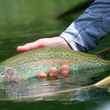



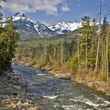
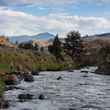




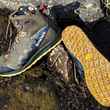



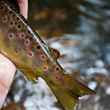
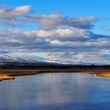


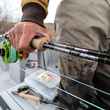

Comments
sebastian replied on Permalink
Very nice story. I have fly fished the Stikine a number of times (last time like you my teenage daughter was along) but a little later so the king run is over and the few still around are spawned out (but many pinks, plus dollies and sea-run cutts). It is as you describe, muddy and glacially-tinted but then upriver there are side channels and creeks that are crystal clear. I have used pink fry/shrimp imitations with great success and the fish in those creeks really don't see much pressure.
Pages